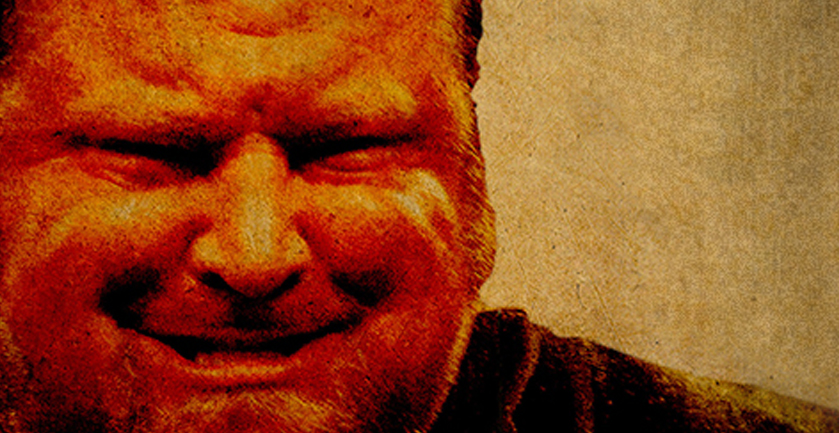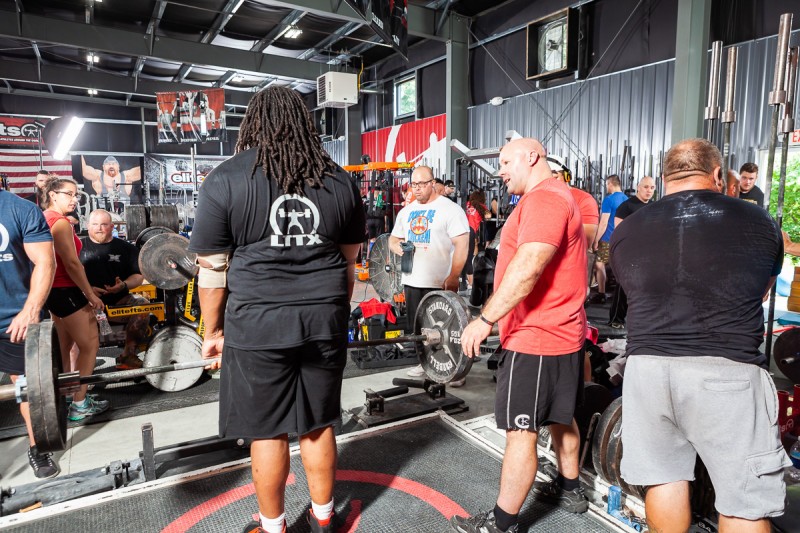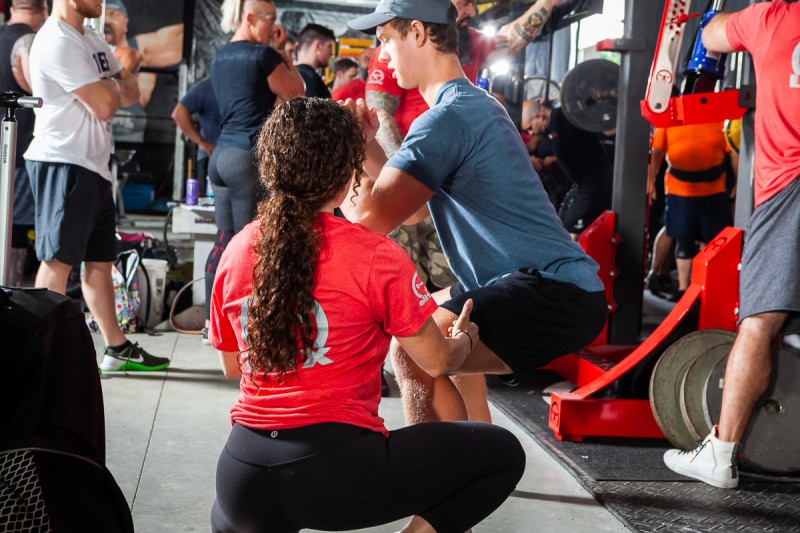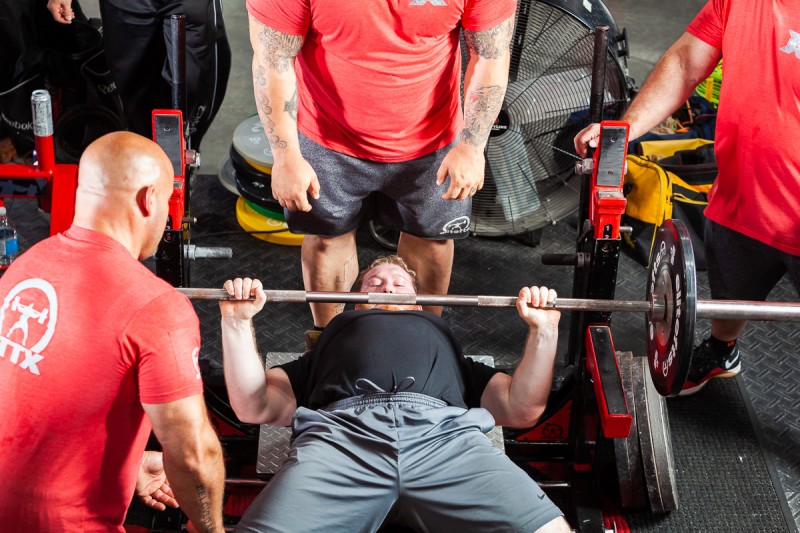
In my last column, I answered the first of five questions I received from a new intern in the strength and conditioning field. In this article, I will discuss my answer to question two.
Do you teach them the squat, bench, and deadlift the same way you would teach a powerlifter? If not, what differences are there?
There is definitely a part of me that wants to answer, “Hell, yes!” and then drop the mic and walk away, but that would not make for a very interesting column even though it would amuse me. Because I would not actually do that, this question does remind me of a conversation I had just the other day. While talking powerlifting with a friend, he said, “We just made a sport out of the exercises other athletes use to get strong for their sport.” This is a pretty funny statement but holds a lot of truths at the same time. The squat, the bench, and the deadlift are without a doubt the three best exercises for building overall strength while also being three of the best exercises for showing overall strength. Do they show athleticism? I don’t think they totally do but can be a sign of it. Do they build athleticism? I believe they can improve it. The fact of the matter is that if they are performed correctly, there are no better exercises for an athlete to do, so they should be a key part of every strength training program.
RECENT: Determining the Needs of an Athlete
The name of the game in powerlifting is to lift the most weight possible in the three lifts. Powerlifters have for decades worked to optimize the technique and training of the three lifts. This means making the movements as efficient as possible. Performing them in the safest manner as possible. Performing them in a way that allows the biggest and strongest muscles to be involved in the lifts. Now, let’s look at this from an athlete’s perspective. What is one of the most important things to keep in mind when training athletes in the weight room? That would be injury prevention. The athletes are there to get stronger so they can perform better on the field, not be set back by injury. This is the same with powerlifters—the biggest setbacks we ever have are due to injury. Why would we not train athletes to perform these vital lifts in the safest manner possible, as powerlifters do?
An athlete also has limited time due to the need to train for his or her sport. This means that time in the weight room is precious and needs to be used efficiently. We should be performing the lifts that best meet our goals without wasting time on exercise with little benefit to our goal. We break this down to working the muscles most important to the goal sport. The three main lifts when performed correctly do just this by working the biggest and strongest of the muscle groups. For powerlifters, these happen to be the posterior chain muscles, which are the most important in sports also. I could simply train squats or 10 other exercises trying to hit all of the muscles that are worked in the squat. Powerlifters are experts at the three main lifts, which happen to be the best three lifts for athletes. Why not learn from powerlifters? Why not use their knowledge seeing that there is so much common ground for doing the lifts?
The three main lifts can also help more than just strength. All three of these lifts are full-body movements and when performed properly teach the athlete to generate power with and through the entire body. They all generate power from the feet up through the body and into the weight. This is the same with most sports where the resistance or force against the ground is key to the athletic movements performed. The power is then generated through the muscles and body to the given throw, swing, hit, etc. By doing these main exercises, an athlete will learn to build tension, stay tight, use the proper muscles, and drive through the whole body. Yes, these movements are stationary, and most athletes move, but there is still major carryover from these lifts. So many of the principles are the same; they just transfer over at different intensity levels. Through these lifts, the athletes will improve at generating power to the ground and through their whole bodies.
The powerlifting movements when performed correctly also teach the proper use of the core, which plays a major role in sports. A strong core is a key component in becoming a top-level powerlifter because it plays such a huge role in the transfer of power through the body into the bar. When the core is weak and unstable, this leaves us susceptible to injury, and it absorbs power. These are things that neither a powerlifter nor an athlete wants. One of the best ways to teach proper core use and to strengthen it is with the main three lifts. Again, the intensity level will be different, but this, too, will be learned through the lifts.
Yet another key element that the big three lifts teach is proper muscle firing and the proper sequence of the firing. Again, a powerlifter is not going to be successful in lifting world-class weights unless he or she mastered these things. These crucial elements will have great carryover into their sports and again help with injury prevention. An example of this that I have come across a lot lately is scapular retraction. I have seen athletes who can barely do this because they have not developed the neuromuscular control needed to do so or they are unable to do it with enough force. As a football player hitting other large athletes, this leaves their shoulders in unsafe and unhealthy positions. If they had been performing the three main lifts with correct technique, I guarantee this would not be a weakness and that their shoulders would be much healthier with less chance of suffering injury.
I believe that the three main lifts should be taught in a similar fashion to how they are taught powerlifters. I will go further to say that what is needed is more of a conjugate-style training. I would have them focus on individual days working with maximum effort, dynamic speed with accommodating resistance, and repetition effort. Each of these plays key roles for the athlete. Basically, everything I have discussed needs to be worked on with maximum effort so that athletes are trained to produce maximal force. Dynamics or speed needs to be worked on for them to produce maximal force at higher speeds. Then, repetition needs to be worked on to help them to be able to hold a position and contract for extended periods of time while also helping to recover from these more quickly. Athletes are required to be mobile and encounter so many different body positions. We need to train them for all of the different situations they come across. Plus, all aspects of strength need to be covered because each plays a role in overall strength. Of course, this style of training would be modified to meet the actual needs of the athlete.
Throughout this column, I have mentioned “correct technique” many, many times, and there is a reason for this. It is paramount to everything I have written. With incorrect technique and training, nothing that I have written will hold up. I have seen so many lifting injuries that are a direct result of the use of incorrect technique. Other times, they are due to incorrect technique used over time, even to the point of poor lifting technique that eventually cause an injury on the field. I have seen injuries from imbalances of the muscles of a joint that all started with incorrect technique followed up with poor training. With improper technique, you may not even be working your core during a lift. I see this way too often. Horrible technique can actually reinforce the incorrect firing patterns of the muscle. This again can be a cause of injury and hinder athletic ability. Honestly, the list of the issues that bad technique can cause goes on and on. Even if you’re talking okay technique, it may not cause many injuries, but it will not yield the benefits of doing it correctly. I grew up hearing, “If you’re going to do a job, then do it right!” I always wanted to get the most out of the time I had in the gym, and for an athlete, this is crucial because time is limited. To be the best and get the best from your lifting, you must use correct technique.

Yes, I would and do train all of my athletes to perform the squat, bench, and deadlift the same way I train powerlifters. There may be minor variation with things like stance and hand width depending on the athlete and his or her needs. I think the real key to this is, as I said, knowing that it takes correct technique to get all of the benefits we can out of these lifts. Unfortunately, many trainers and coaches do not know what correct technique is. They think it is just about pushing weight to get stronger. Yes, this works, but it most certainly is not optimum or efficient with limited time. In the collegiate world, there is also the time factor that strength and conditioning coaches have to deal with. They have to coach large numbers of athletes in short amounts of time. I am fortunate to work either in small groups or one on one so that I am able to teach technique properly and stay on top of it. In most college situations, athletes do not have this benefit, which is sad. I think the only way it can be done is to hold athletes responsible for each other, but there still needs to be some time to actually teach them first. Even in the world of powerlifting, there are so many coaches and athletes who do not understand proper technique. I think this is again sad because I am sure it puts up a wall between powerlifting and the training of athletes. Hell, if I did not know powerlifting but watched Instagram powerlifting and was a football coach, I might think, “There is no way in hell I am letting these people train my athletes!”
As it is, I just shake my head at about half of what I see on social media pertaining to powerlifting. Hopefully, over time, we can fix this and get together to benefit all sports and lifters. I truly believe that all athletes should perform the three main power lifts in the same fashion as top-notch elite-level powerlifters. All of the coaches or trainers I know and respect have their athletes do the same. It always works, and the athletes always reap great rewards in performance from it.













1 Comment